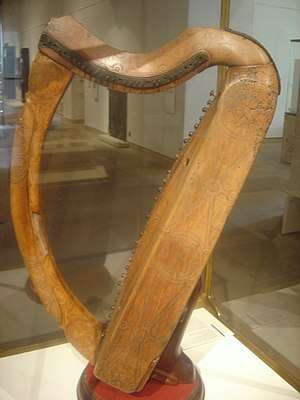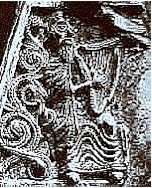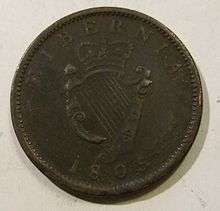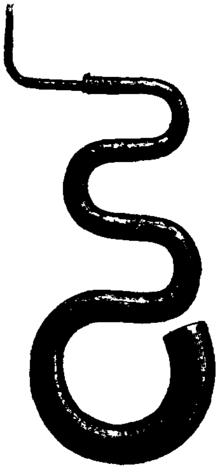Celtic harp
The Celtic harp is a square harp traditional to Ireland and Scotland. It is known as cláirseach in Irish and clàrsach in Scottish Gaelic. In Ireland and Scotland, it was a wire-strung instrument requiring great skill and long practice to play, and was associated with the Gaelic ruling class. It appears on Irish and British coins and coat of arms of the Republic of Ireland, the United Kingdom and Canada.
 The medieval 'Queen Mary harp' (Clàrsach na Banrìgh Màiri) preserved in the National Museum of Scotland, Edinburgh | |
| String instrument | |
|---|---|
| Other names | cláirseach, clàrsach, telenn, telyn |
| Classification |
|
| Hornbostel–Sachs classification | 322.221 (manually tuned frame harp) |
| Related instruments | |
Early history


The early history of the triangular frame harp in Europe is contested. The first instrument associated with the harping tradition in the Gaelic world was known as a cruit. This word may originally have described a different stringed instrument, being etymologically related to the Welsh crwth. It has been suggested that the word clàrsach / cláirseach (from clàr / clár, a board) was coined for the triangular frame harp which replaced the cruit, and that this coining was of Scottish origin.[1]
The connection of Scotland its love of stringed instruments is both ancient and recorded. An Iron Age lyre dating to circa 300 BC was discovered on the Isle of Skye making it Europes earliest surviving stringed instrument.[2][3] The earliest descriptions of a European triangular framed harp i.e. harps with a fore pillar are found on carved 8th century Pictish stones.[4][5][6][7][8][9] Pictish harps were strung from horsehair. The instruments apparently spread south to the Anglo Saxons who commonly used gut strings and then west to the Gaels of the Highlands and to Ireland.[10][11][12][13] Exactly thirteen depictions of any triangular chordophone instrument from pre-11th-century Europe exist and twelve of them come from Scotland.[14] Moreover, the earliest Irish word for a harp is in fact 'cruit', a word which strongly suggests a Pictish provenance for the instrument.[15] Only two quadrangular instruments occur within the Irish context on the west coast of Scotland and both carvings instruments date two hundred years after the Pictish carvings.[13] The first true representations of the Irish triangular harp do not appear till the late eleventh century in reliquary and the twelfth century on stone and the earliest harps used in Ireland were quadrangular lyres as ecclesiastical instruments,[8][13][16] One study suggests Pictish stone carvings may be copied from the Utrecht Psalter, the only other source outside Pictish Scotland to display a Triangular Chordophone instrument.[17] The Utrecht Psalter was penned between 816–835 AD.[18] While Pictish Triangular Chordophone carvings found on the Nigg Stone dates from 790–799 AD.[19] and pre-dates the document by up to thirty-five to forty years. Other Pictish sculptures predate the Utrecht Psalter, namely the harper on the Dupplin Cross c. 800 AD.
Three of the four oldest authentic harps to survive are of Gaelic provenance: the Trinity College harp preserved in Trinity College Dublin, and the Queen Mary Harp and the Lamont Harp in the National Museum of Scotland, Edinburgh.[20] The last two are examples of the small low-headed harp, and are both made from hornbeam, a wood not native to Scotland or Ireland.[21] All three are dated approximately to the 15th century and may have been made in Argyll in western Scotland.[22][23] Many “Irish” harps from later periods have no provenance and could possibly be of Scottish origin.[24]
The Norman-Welsh cleric and scholar Gerald of Wales (c.1146 – c.1223), whose Topographica Hibernica et Expugnatio Hibernica is a description of Ireland from the Anglo-Norman point of view, praised Irish harp music (if little else), but added that, in the opinion of many, the Scots had now surpassed them in that skill.[25] Gerald refers to the cythara and the tympanum, but their identification with the harp is uncertain, and it is not known that he ever visited Scotland.[26]
Scotland, because of her affinity and intercourse [with Ireland], tries to imitate Ireland in music and strives in emulation. Ireland uses and delights in two instruments only, the harp namely, and the tympanum. Scotland uses three, the harp, the tympanum, and the crowd. In the opinion, however, of many, Scotland has by now not only caught up on Ireland, her instructor, but already far outdistances her and excels her in musical skill. Therefore, [Irish] people now look to that country as the fountain of the art.
— Gerald of Wales[27]
Early images of the clàrsach are not common in Scottish iconography, but a gravestone at Kiells, in Argyllshire, dating from about 1500, shows one with a typically large soundbox, decorated with Gaelic designs.[28] The Irish Maedoc book shrine dates from the 11th century, and clearly shows a harper with a triangular framed harp including a "T-Section" in the pillar. The Irish word lamhchrann or Scottish Gaelic làmh-chrann came into use at an unknown date to indicate this pillar which would have supplied the bracing to withstand the tension of a wire-strung harp.
Three pre-16th-century examples survive today; the Brian Boru Harp in Trinity College, Dublin, and the Queen Mary and Lamont Harps, both in Scotland.
One of the largest and most complete collections of 17th–18th century harp music is the work of Turlough O'Carolan, a blind, itinerant Irish harper and composer. At least 220 of his compositions survive to this day.
Characteristics and function
In construction the Irish and Scottish harp may in general be considered as one. A characteristic feature is the metal strings. Historical sources mention various types of wire,[29] including brass and iron; some scholars also argue for the use of silver and gold.[30] The wires were attached to a massive soundbox typically carved from a single log, commonly of willow, although other woods including alder and poplar have been identified in extant harps. This harp also had a reinforced curved pillar and a substantial neck, flanked with thick brass cheek bands. The strings, usually played with the fingernails, produced a brilliant ringing sound.[31] This type of harp is also unique amongst single row triangular harps in that the first two strings tuned in the middle of the gamut were set to the same pitch.[32]
Components
In Scottish Gaelic, the names of the components of the clàrsach were as follows:
- amhach (neck)
- cnagan (pins)
- corr (pin-board)
- com (chest or soundbox)
- làmh-chrann (tree or forepillar)
- teudan (strings)
- cruidhean nan teud (string shoes)
- urshnaim (toggle?).[33][34]
The corr had a brass strap nailed to each side, pierced by tapered brass tuning pins. The treble end had a tenon which fitted into the top of the com (soundbox). On a low-headed harp the corr was morticed at the bass end to receive a tenon on the làmh-chrann; on a high-headed harp this tenon fitted into a mortice on the back of the làmh-chrann.
The com (soundbox) was usually carved from a single piece of willow, hollowed out from behind. A panel of harder timber was carefully inserted to close the back.
Cruidhean nan teud (string shoes) were usually made of brass and prevented the metal strings from cutting into the wood of the soundbox.
The urshnaim may refer to the wooden toggle to which a string was fastened once it had emerged from its hole in the soundboard.
Playing technique
The playing of the wire-strung harp has been described as extremely difficult. Because of the long-lasting resonance, the performer had to dampen strings which had just been played while new strings were being plucked, and this while playing rapidly. Contrary to conventional modern practice, the left hand played the treble and the right the bass. It was said that a player should begin to learn the harp no later than the age of seven. The best modern players have shown, however, that reasonable competence may be achieved even at a later age.
Social function and decline
During the medieval period the wire-strung harp was in demand throughout the Gaelic territories, which stretched from the northern Highlands and Western Isles of Scotland to the south of Ireland. The Gaelic worlds of Scotland and Ireland, however, while retaining close links, were already showing signs of divergence in the sixteenth century in language, music and social structure.
The function of the clàrsach in a Hebridean lordship, both as entertainment and as literary metaphor, is illustrated in the songs of Màiri Nic Leòid (Mary MacLeod) (c.1615 – c.1705), a prominent Gaelic poet of her time. The chief is praised as one who is skilled in judging harp-playing, the theme of a story and the pith of sense:
- Tuigsear nan teud,
- Purpais gach sgèil,
- Susbaint gach cèill nàduir.[35]
The music of harp and pipe is shown to be intrinsic to the splendour of the MacLeod court, along with wine in shining cups:
- Gu àros nach crìon
- Am bi gàirich nam pìob
- Is nan clàrsach a rìs
- Le deàrrsadh nam pìos
- A' cur sàraidh air fìon
- Is 'ga leigeadh an gnìomh òircheard.[36]
Here the great Highland bagpipe shares the high status of the clàrsach. It would help supplant the harp, and may already have developed its own classical tradition in the form of the elaborate “great music” (ceòl mòr). An elegy to Sir Donald MacDonald of Clanranald, attributed to his widow in 1618, contains a very early reference to the bagpipe in a lairdly setting:
- Is iomadh sgal pìobadh
- Mar ri farrum nan dìsnean air clàr
- Rinn mi èisdeachd a’d’ bhaile... [37]
There is evidence that the musical tradition of the clàrsach may have influenced the use and repertoire of the bagpipe. The oral mnemonic system called canntaireachd, used for encoding and teaching ceòl mòr, is first mentioned in the 1226 obituary of a clàrsair (harp player). Terms relating to theme and variation on the clàrsach and the bagpipe correlate to each other. Founders of bagpipe dynasties are also noted as clársach players.[37]
The names of a number of the last harpers are recorded. The blind Duncan McIndeor, who died in 1694, was harper to Campbell of Auchinbreck, but also frequented Edinburgh. A receipt for "two bolls of meall", dated 1683, is extant for another harper, also blind, named Patrick McErnace, who apparently played for Lord Neill Campbell. The harper Manus McShire is mentioned in an account book covering the period 1688 to 1704. A harper called Neill Baine is mentioned in a letter dated 1702 from a servitor of Allan MacDonald of Clanranald. Angus McDonald, harper, received payment on the instructions of Menzies of Culdares on 19 June 1713, and the Marquis of Huntly’s accounts record a payment to two harpers in 1714. Other harpers include Rory Dall Morison (who died c.1714), Lachlan Dall (who died c.1721–27) and Murdoch MacDonald (who died c.1740).[38]
By the middle of the eighteenth century the “violer” (fiddle player) had replaced the harper, a consequence, perhaps, of the growing influence in the Gaelic world of Lowland Scots culture.[38]
Revival

In the early 19th century, even as the old Gaelic harp tradition was dying out, a new harp was invented in Ireland.[39] It had gut strings and semitone mechanisms like an orchestral pedal harp, and was invented by Dublin pedal harp maker John Egan. It was small and curved like the historical cláirseach or Irish harp, but its strings were of gut and the soundbox was much lighter.[40] In the 1890s a similar new harp was also developed in Scotland as part of a Gaelic cultural revival.[41]
There is now, however, renewed interest in the wire-strung harp, or clàrsach, with replicas being made and research being conducted into ancient playing techniques and terminology.[42]
Bibliography
- Armstrong, Robert Bruce, The Irish and The Highland Harps (Edinburgh: David Douglas, 1904).
- Bannerman, John, "The Clàrsach and the Clàrsair", in: Scottish Studies vol. 30 no. 3 (1991).
- Budgey, Andrea, "Musical relations between Scotland and Ireland", in: R. Andrew McDonald (ed.), Literature and Music in Scotland: 700–1560 (University of Toronto Press, 2002), ISBN 0802036015; ISBN 978-0802036018.
- Caldwell, D. H. (ed.), Angels, Nobles and Unicorns: Art and Patronage in Medieval Scotland (Edinburgh: NMS, 1982).
- Cathcart, Cynthia, "Silver Report: Precious Metal Strings on the Wire-Strung Harp", in: Folk Harp Journal no. 143 (Summer 2009), pp. 34–43; available online at http://wirestrungharp.com/material/silver_report.html.
- Chadwick, Simon, "The Early Irish Harp", in: Early Music vol 36 no.4 (November 2008), pp. 521–532.
- Collinson, Francis, The Bagpipe, Fiddle and Harp (Routledge & Kegan Paul, 1966; reprinted by Lang Syne Publishers Ltd., 1983), ISBN 0946264481; ISBN 978-0946264483.
- Dimock, James F. (ed.), Giraldi Cambrensis opera: Giraldi Cambrensis Topographica Hibernica et Expugnatio Hibernica (London: Longmans, Green, Reader, and Dyer, 1867).
- Farmer, Henry George, A History of Music in Scotland (London, 1947), p. 280.
- Heymann, Ann and Heymann, Charlie, "Cláirseach: The Lore of the Irish Harp", in: Éire-Ireland vol. 26 no. 3 (Fall 1991).
- Heymann, Ann and Heymann, Charlie, "Strings of Gold", in: The Historical Harp Society Journal vol. 13 no.3 (Summer 2003), pp. 9–15. Online version at http://www.annheymann.com/gold.htm.
- Lanier, Sara C., "'It is new-strung and shan't be heard'": Nationalism and Memory in the Irish Harp Tradition", in: British Journal of Ethnomusicology, vol. 8 (1999).
- Lawlor, Helen, Irish Harping, 1900–2010 (Dublin: Four Courts Press, 2012), ISBN 978-1-84682-367-1.
- Newton, Michael and Cheape, Hugh: "The Keening of Women and the Roar of the Pipe: From Clársach to Bagpipe, ca. 1600–1782":
- Ó Brógáin, Séamas, The Irish Harp Emblem (Dublin: Wolfhound Press, 1998); ISBN 0-86327-635-0.
- O'Donnell, Mary Louise, Ireland's Harp: The Shaping of Irish Identity c.1770–1880 (Dublin: UCD Press, 2014), ISBN 978-1-90635-986-7.
- Rensch, Roslyn, Harps and Harpists (Indiana University Press, 1989), pp. 125–127.
- Rimmer, Joan, "The Morphology of the Irish Harp", in: The Galpin Society Journal no. 17 (1964).
- Rimmer, Joan, The Irish Harp: Cláirseach na hÉireann (The Mercier Press, 1969; 2nd ed. 1977, 3rd ed. 1984), ISBN 0-85342-151-X.
- Sanger, Keith and Kinnaird, Alison, Tree of Strings – Crann nan Teud (Kinmor Music, 1992), ISBN 0-95112-044-1.
- Watson, J. Carmichael (ed.), Gaelic Songs of Mary MacLeod (Blackie & Son, 1934): https://archive.org/stream/gaelicsongsofmar00macl/gaelicsongsofmar00macl_djvu.txt.
- Yeats, Gráinne, Féile na gCruitirí, Béal Feirste/The Belfast Harpers’ Festival 1972 (Gael Linn, 1980), ISBN 0-86233-025-4.
References
- John Bannerman, 'The Clàrsach and the Clàsair' in Scottish Studies 30, 1991, pp. 3–4.
- "'Europe's oldest stringed instrument' discovered on Scots island | Highlands & Islands". News. 28 March 2012. Retrieved 1 August 2015.
- "Skye cave find western Europe's 'earliest string instrument'". BBC News. 28 March 2012.
- Montagu, Jeremy (2002). "Harp". In Alison Latham (ed.). The Oxford Companion to Music. London: Oxford University Press. pp. 564. ISBN 978-0-19-866212-9. OCLC 59376677.
- The Anglo Saxon Harp, 'Spectrum, Vol. 71, No. 2 (Apr. 1996), pp. 290–320.
- The Origins of the Clairsach or Irish Harp. Musical Times, Vol. 53, No. 828 (February 1912), pp. 89–92.
- Scotland, Insight Guides. Josephine Buchanan 2003, pp94 Published 2003 Langenscheidt Publishing Group.
- John T. Koch Celtic Culture: A Historical Encyclopedia 2006. Published ABC-CLIO, pp1276.
- Scotland's Music: A History of the Traditional and Classical Music of Scotland from Early Times to the Present Day. John Purser (2007) Mainstream Publishing Group.
- A New History of Ireland, prehistoric and early history. Daibhi OCoinin (2005). Oxford University Press.
- J. Keay & Julia Keay. (2000): Collins Encyclopaedia of Scotland, Clarsach, p. 171. Harper Collins publishers.
- History Literature and music in Scotland 1700-1560 Russell Andrew McDonald 2002 University of Toronto Press, Arts Medieval Recent introduction from Scotland to Ireland of the triangular harp.
- Celtic Music History and Criticism Kenneth Mathieson 2001 Backbeat books p192
- Alasdair Ross, "Pictish Chordophone Depictions", in Cambrian Medieval Celtic Studies, 36, 1998, esp. p. 41; Joan Rimmer, The Irish Harp, (Cork, 1969) p. 17.
Also: Alasdair Ross discusses that all the Scottish harp figures were copied from foreign drawings and not from life, in 'Harps of Their Owne Sorte'? A Reassessment of Pictish Chordophone Depictions "Cambrian Medieval Celtic Studies" 36, Winter 1998 - J. Keay & Julia Keay. (2000): Collins Encyclopaedia of Scotland, Clarsach, p. 171. Harper Collins publishers.
- The Story of the Irish Harp its History and Influences Norah Joan Clark (2003) North Creek Press
- Alasdair Ross discusses that all the Scottish harp figures were copied from foreign drawings and not from life, in 'Harps of Their Owne Sorte'? A Reassessment of Pictish Chordophone Depictions "Cambrian Medieval Celtic Studies" 36, Winter 1998
- Snyder's Medieval Art, 2nd ed, p32. Luttikhuizen and Verkerk
- "The Nigg stone is dated before the Utrecht Psalter and cannot have influenced the Pictish carvers to copy harp figures from the Ross study". Strathclyde University : STAMS Pictish Stones Search Facility. Retrieved 1 August 2015.
- "Early Gaelic Harp Info: old harps in museums". www.earlygaelicharp.info.
- Rimmer 1969, p. 35.
- See Sanger & Kinnaird 1992
- See Caldwell 1982.
- "old harps". Early Gaelic Harp Info. Retrieved 9 October 2013.
- Dimock 1867 (ed.), pp. 154–5: Multorum autem opinione, hodie Scotia non tantum magistram aequiparavit Hiberniam, verum etiam in musica peritia longe praevalet et praecellit. Unde et ibi quasi fontem artis jam requirunt.
- Budgey 2002, p. 209.
- Gerald of Wales, "Topographia Hibernica", 94; tr. John O'Meary, The History and Topography of Ireland (London, 1982).
- Rimmer 1969, pp. 35–37.
- "Early Gaelic Harp Info: stringing". www.earlygaelicharp.info.
- See Heymann 2003.
- Rimmer 1969, p. 34.
- Rimmer 1969, p. 54.
- Dwelly 1901–11, 1977, p. 206: clàrsach.
- "Irish Terms". Early Gaelic Harp Info. 21 October 2002. Retrieved 9 October 2013.
- Watson 1934, 46 – Crònan an Taibh.
- Watson 1934: 62 – An Crònan.
- Newton & Cheape, pp. 77–78.
- Keith Sanger, 'Final Chords—the Last Scottish Harpers'; WireStrungHarp.
- "Early Gaelic Harp Info: history (19th Century)". www.earlygaelicharp.info.
- Rimmer 1969. p. 67.
- See Collinson 1983.
- "Ann Heymann | Portland Clarsach". Pdxclarsach.wordpress.com. Retrieved 9 October 2013.
External links
| Wikimedia Commons has media related to Celtic harps. |
| Look up clarsach in Wiktionary, the free dictionary. |
- Historical Harp Society of Ireland
- An Chúirt Chruitireachta, International traditional harp course held annually in Termonfeckin Co. Louth, Ireland
- The Clarsach Society/Comunn na Clarsaich, resource centre for the Scottish harp
- Edinburgh International Harp Festival
- List of surviving early Gaelic harps
- Historic wire-strung harps and harpers listed and described on wirestrungharp.com
- Gaelic Modes Web articles on Gaelic harp harmony and modes
- Treasures of early Irish art, 1500 B.C. to 1500 A.D., an exhibition catalogue from The Metropolitan Museum of Art (fully available online as PDF), which contains material on Clàrsach (cat. no. 68)
- Asni: harp lore – descriptions of several types of historical European harps (with sound samples)
- The Celtic Harp Page – information on Celtic and other types of harps
- My Harp's Delight – learning to play the Celtic harp, tips and techniques, buying a harp
- Teifi Harps – Celtic & Folk Harps in Wales
- "Tears, Laughter, Magic" – An Interview with Master Celtic Harp Builder Timothy Habinski on AdventuresInMusic.biz, 2007
- Celtic Harp Amplification Series – using microphones and guitar amplifiers with folk harps
- Markwood Strings – Information on installing harp strings, harp string installation guide
- Early Gaelic Harp site by Simon Chadwick

